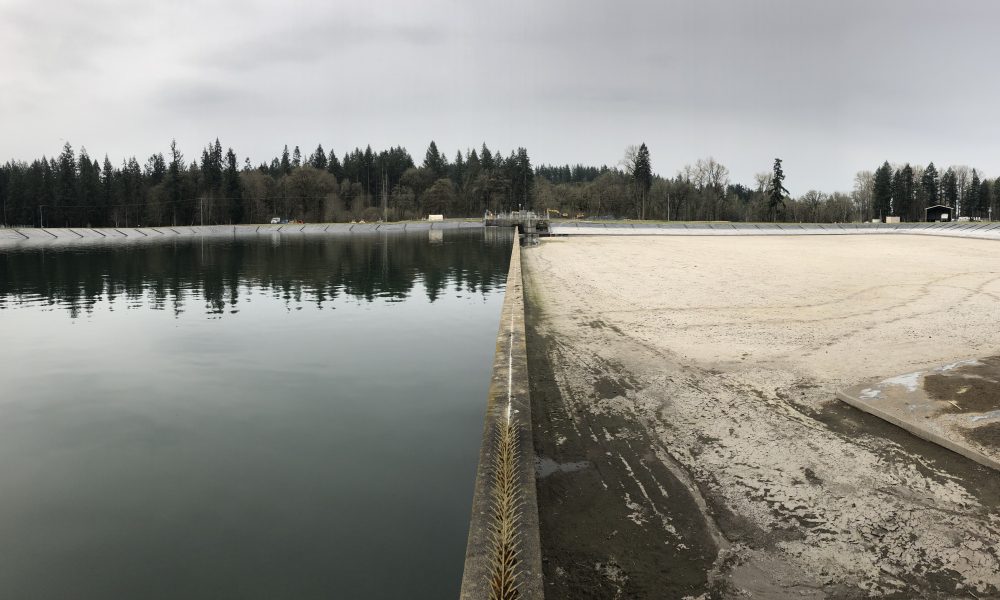 Treatment ponds at Geren Island which ultimately becomes drinking water for Salem residents. Water reaching this point will have already been treated with powdered-activated carbon. (Troy Brynelson/Salem Reporter)
Treatment ponds at Geren Island which ultimately becomes drinking water for Salem residents. Water reaching this point will have already been treated with powdered-activated carbon. (Troy Brynelson/Salem Reporter)
Following Salem’s brush with cyanotoxins, Devin Doring said everyone at the city of Salem faced the question: How can they stop this from happening again?
“It was obvious that we weren’t as prepared as we should have been and of course everyone started putting on their thinking caps,” said Doring, the city’s technical services supervisor.
That was 10 months ago when the toxins breached the city’s drinking water supply for the first time in the system’s 80-year history. The uncertainty of what the breach meant sent people scouring stores for bottled water.
Today, like cherry blossoms at the Capitol Mall, algae may already be sprouting in Detroit Lake. Blooms that can produce cyanotoxins could occur by the end of the month.
The city, however, is trying to make sure the breach remains a one-time occurrence. Millions of dollars’ worth of projects and initiatives are in the works.
A $40 million ozone treatment plant is one. The facility will be at Geren Island, where water is already treated from the North Santiam River, and will inject a gaseous stream of ozone into the water to attack microbes.
READ: Salem secures financing for new ozone-based water treatment, plans underway
But that facility isn’t expected to be running until 2021, and the city has made other investments as algae season picks up.
The city has earmarked $3.5 million to modify its existing Geren Island plant, widening the settling pools where powdered-activated carbon can treat cyanobacteria before the ozone facility is complete. Salem has 250,000 pounds of powdered-activated carbon ready to go.
In January, Salem City Council approved the hire of two more employees for Geren Island, who will dose the water with powdered-activated carbon and monitor for algal blooms. The city bought themselves two $30,000 devices to test water on-site so it no longer has to send water samples to Ohio.
“We rolled up our sleeves and got to work,” said Nitin Joshi, who oversees environmental issues as the city’s environmental and regulatory affairs manager. “Water needed help and we all decided we needed to help water as best we can.”
Those sleeves rolled up quickly after the first advisory last May, but it was a month later that Doring, Joshi and other city staff convened with about 30 scientists at Oregon State University.
Doring called it a symposium where scientists from an array of backgrounds and disciplines brainstormed ways to learn more about harmful algal blooms and ultimately thwart them.
“We had professors, grad students, post docs – we really sliced and diced this thing,” Doring said of the meeting.
That’s where he met Dr. James Watson and Mathew Titus, an assistant professor and a postdoctoral researcher at OSU, respectively. The two had recently founded The Prediction Lab, a private enterprise to analyze data, such as the water data the city collects.
 The intake area of Geren Island, where water from the North Santiam River flows to become drinking water. Water here is on its way to be treated with powdered-activated carbon, if such treatment is underway. (Troy Brynelson/Salem Reporter)
The intake area of Geren Island, where water from the North Santiam River flows to become drinking water. Water here is on its way to be treated with powdered-activated carbon, if such treatment is underway. (Troy Brynelson/Salem Reporter)
Harmful algal blooms are becoming more common, which Watson tied to the increasingly hot temperatures.
“Harmful algal blooms are actually a normal thing. They occur naturally, but they have historically been rare,” he said. He noted the last four years in Oregon have been the hottest on record. “They’re just like any other plant: you give them nutrients, give them light, and they’ll grow.”
“Pretty much it’s going to happen at least once a year. I think the city of Salem knows this and good on them. I think they’re quite forward looking, because this problem isn’t going to go away. It’s only going to get worse,” he said.
After the meeting, Salem contracted The Prediction Lab for $25,000 to design and implement ways to predict blooms in Detroit Lake.
In practice, two public works staffers boat the lake and take water samples that help discern concentrations of elements like nitrogen or phosphorous — algae food.
The data is then shared with The Prediction Lab, who punches the data into their predictive models. The models also factor weather conditions at the lake, like the amounts of rain, wind and sunlight.
“They send it to us, we run our models, it takes awhile for the numbers to be crunched and we produce our predictions within a few days,” said Titus. “Those predictions are for the next seven days.”
The week of March 28 through April 4, for example, showed a 25 percent chance of “some algae” in Detroit Lake but no chance of toxins. Watson and Titus said The Prediction Lab tested its models from last summer’s data and found they were correct more than 90 percent of the time.
“We don’t know for sure what’s going to happen, we are giving the city our best guess,” Titus said.
If algae does grow due to higher concentrations of nitrogen or phosphorous, the models also won’t be able to deduce where those elements are coming from.
Finding what fed the algae was an objective championed last summer by Mayor Chuck Bennett. Doring said keeping a closer eye on the water could help lead to the source — or sources.
“We heard the mayor’s marching orders, his call, very loud and clear,” Doring said. “We thought in this way we could help address that mandate. It’s a big problem. It’s very complicated.”
READ: Bennett biding his time, but plans to seek investigation into city’s water crisis
Complicated enough that the city is seen as a sort of a lab rat for cities dealing with harmful algal blooms.
City spokesman Kenny Larson said he and Deputy Fire Chief Gabe Benmoussa have recently spoken emergency management conferences in Oregon. Technical experts in the city’s public works department have also been flown to conferences to share their experiences.
Recently, Larson, Benmoussa and other Salem staffers went to a training in Alabama hosted by the Federal Emergency Management Agency. When a test run came up about dealing with a series of emergencies, which included problems with drinking water, a staffer from elsewhere in the United States leaned over to Larson.
“One person was like ‘Was it this crazy during the water advisory?’ because they knew about it. I said, ‘Yeah it was.’” Larson said. “Her eyes opened and she said ‘Woah, OK then.’”
Larson and Benmoussa said they have set up more protocols for communicating with the public better during an emergency.
Larson, the city employee who initially sent the emergency messages that stirred much of the panic in May, described those weeks as a lesson.
“It was a stress test on everybody’s systems,” he said. “We were learning and adapting as fast as we could on the fly. It was pretty neat — in retrospect. While we were going through it, it was difficult for us, of course.”
This summer it will be a different story.
“We’re prepared this year,” he said. “That’s the fundamental message: We’re prepared.”
Have a tip? Contact reporter Troy Brynelson at 503-575-9930, [email protected] or @TroyWB.
 Settling ponds at Geren Island, pictured on Monday. Water here will have been treated with powdered-activated carbon and awaits flowing into the treatment ponds. (Troy Brynelson/Salem Reporter)
Settling ponds at Geren Island, pictured on Monday. Water here will have been treated with powdered-activated carbon and awaits flowing into the treatment ponds. (Troy Brynelson/Salem Reporter)









